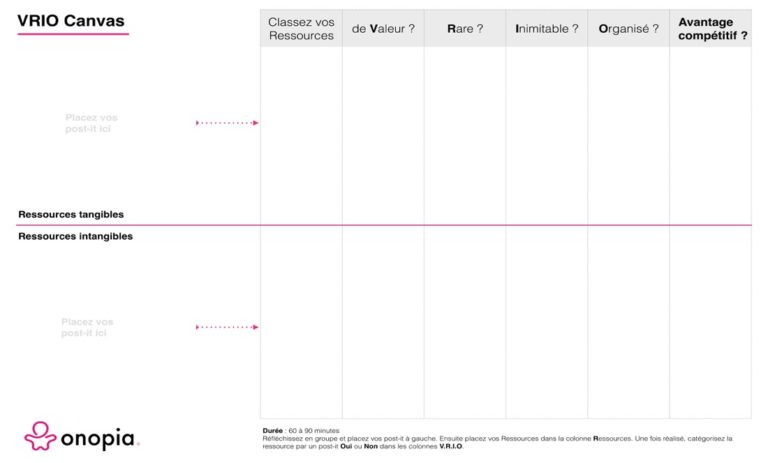
VRIO Canvas
VRIO is a business analysis framework that forms part of a firm’s larger strategic scheme.

BOX
Strategy Toolbox
Temps suggéré
90 minutes
Niveau de Difficulté
Expert
Matériels Nécessaires
Participants
We’re all born storytellers. Stories are how we have shared knowledge and information since the dawn of humanity. Our brains are shaped by storytelling. Still, not everyone can aspire to be the next Hemingway from the get go. But don’t be afraid: stories can be designed! The storytelling canvas helps you to do just that!
HOW TO USE THE STORYTELLING CANVAS
We created the storytelling canvas to make it easier to construct a story that people care to listen to. The PowerPoint presentations you give probably lack the emotional depth and impact you want to build in a story. However, the stories we design can be told through the medium of PowerPoint!
Like the other tools in this book, the story canvas allows you to collectively design stories that resonate: by harnessing visual, engaging, insightful, controlled, and inspiring elements.
STEP BY STEP GUIDE
1 BEFORE YOU START
What do you want to achieve with your story? Why do you want to tell it?
2 WHAT DO YOU WANT TO ACHIEVE?
What you’ll need to understand when designing your story is that there must be a goal. What do you want your audience to know, feel, or do afterwards? Your goal needs to be quite selective: you can make only a few points in your story!
3 WHO ARE IN THE AUDIENCE?
In addition to knowing what you want to achieve, you need to understand who your audience is. What do they care about? Why should they listen to your story? Different audiences need different stories; one size does not fit all! You might even use the right side of the value proposition canvas or a persona canvas to map the audience. Test your assumptions: while designing and telling the story, revisit your persona, and update it with what you learned.
TIPS
IF YOU ARE PITCHING TO AN INVESTOR, THE CUSTOMERS OF YOUR PRODUCT ARE NOT NECESSARILY THE AUDIENCE OF YOUR STORY. YOUR INVESTOR HAS A TOTALLY DIFFERENT SET OF NEEDS THAN YOUR CUSTOMER.
4 MAP THE AUDIENCE’S BEFORE AND AFTER STATE.
In order to be meaningful, your story should change your audience in some way. Their beliefs, emotions, or knowledge should be transformed by the time you are finished.
First, ask yourself: How does your audience feel about your goal before they heard your story? Do they care about it already? And then, think about what you’d like them to think about once you’re through? Trying to define it from the audience’s perspective is key.
5 CREATE THE STORY
Try to come up with arguments that may change their minds, and make sure you have a list of rational, emotional, and ethical points. What is your “proof”? Do you have examples? Anecdotes? Find the ones that will resonate with your audience.
There are different key ingredients that you can use to plot your audience’s journey through the story. With your team, spend time to come up with a good number of these. Don’t bother about the order yet, just try to find as many as you can.
Source : Designabetterbusiness.tools

VRIO is a business analysis framework that forms part of a firm’s larger strategic scheme.

DECOUVREZ LES sites pour co-créer en ligne votre
Le 11 JUIN 2024 • Workshop en ligne
Apprenez à créer un modèle économique durable et/ou circulaire avec le Flourishing Business Canvas©

Business Model Innovation & Proposition de Valeur Centrée Client


Recevez nos études et invitations à nos webinaires !